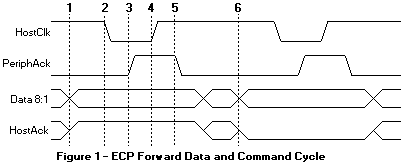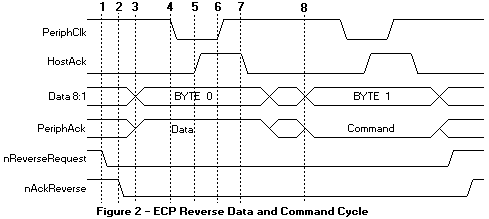|
|
| SPP Signal | ECP Mode Name | In/Out | Description Signal usage when in ECP Mode data transfer |
|---|---|---|---|
| nSTROBE | HostClk | Out | Used with PeriphAck to transfer data or address information in the forward direction. |
| nAUTOFEED | HostAck | Out | Provides Command/Data status in the forward direction. Used with PeriphClk to transfer data in the reverse direction. |
| nSELECTIN | 1284Active | Out | Set high when host is in a 1284 transfer mode. |
| nINIT | nReverseRequest | Out | Driven low to put the channel in reverse direction. |
| nACK | PeriphClk | In | Used with HostAck to transfer data in the reverse direction. |
| BUSY | PeriphAck | In | Used with HostClk to transfer data or address information in the forward direction. Provides Command/Data status in the reverse direction. |
| PE | nAckReverse | In | Driven low to acknowledge nReverseRequest. |
| SELECT | Xflag | In | Extensibility flag. |
| nERROR | nPeriphRequest | In | Set low by peripheral to indicate that reverse data is available. |
| Data[8:1] | Data[8:1] | Bi-Di | Used to provide data between the peripheral and host. |
Figure 1 shows two forward data transfer cycles. When HostAck is high it
indicates that a data cycle is taking place. When HostAck is asserted low, a command
cycle is taking place and the data represents either an RLE count or a Channel address.
Bit 8, of the data byte is used to indicate RLE vs. Channel address. If bit 8 is 0, then bits
1-7 represent a Run_Length Count (0-127). If bit 8 is 1, then bits 1-7 represent a Channel
address (0-127). Figure 6 shows a data cycle followed by a command cycle.
Figure 2 shows a reverse channel command cycle followed by a reverse channel
data cycle. The I/O read or write strobes are not shown in these figures. This is because
the ECP FIFOs are used to decouple the ISA data transfers, either DMA or programmed
I/O, from the actual host/peripheral data transfers. It is this decoupling of the transfer
states that makes the ECP protocol a 'loosely coupled' protocol. The software driver
does not know the exact state of the data transfers. If a large block is being transferred via
DMA, the driver does not know if the 123rd byte is being transferred or the 342,201st
byte. As in the case of printers, the software may not care. The only concern is whether
the transfer was completed or not.


ECP Software and Register Interface
The Microsoft specification, 'The IEEE 1284 Extended Capabilities Port Protocol
and ISA Interface Standard', defines a common register interface for ISA based 1284
adapters with ECP. This specification also defines a number of operational modes that the
adapter can operate under. Table 2 identifies these modes.
Table 2 -- ECR Register Modes
| Mode | Description |
|---|---|
| 000 | SPP mode |
| 001 | Bi-directional mode (Byte mode) |
| 010 | Fast Centronics |
| 011 | ECP Parallel Port mode |
| 100 | EPP Parallel Port mode (Note 1) |
| 101 | (reserved) |
| 110 | Test mode |
| 111 | Configuration mode |
(Note 1) This mode is implemented by the SMC FDC37C665/666 controller and is not defined by the ECP specification. Most 1284 I/O controllers implement the EPP mode in a similar fashion.
The register model for an ECP port is similar to that of the standard parallel port,
but takes advantage of a significant design oddity of the ISA bus architecture. In the IBM
compatible PC architecture, only the first 1024 I/O ports, or addresses, are used. This is
the basic I/O space of 0x000h to 0x3ffh. In order to address this range of addresses, only
10 address bits are needed (AD0-9). In order to save cost, older PC's only drove and
decoded these address bits on the ISA bus and therefore limited the available I/O space to
these 1024 registers. Newer PC's, actually drive and decode more address bits, enabling a
larger available I/O space. This creates, in effect, multiple 'pages' of the first 1K I/O
ports. A software driver can access these pages by adding 1024 (0x400h hex notation) to
the base address being accessed. Therefore, addressing addresses 0x378h and 0x778h can
access 2 registers on two separate pages, but be guaranteed not to interfere with any other
installed ISA device. The advantage is that by using this 'aliasing' effect, new cards can
have 'hidden' registers, thus expanding the available number of registers available, and
still maintain compatibility with older ISA cards that only decode 10 address bits.
The ECP register model takes advantage of this and defines 6 registers that only
require 3 actual I/O ports. Table 9 identifies these registers. Note that the register
definition may be dependent upon the current mode of operation. The ECR register is the
most important aspect of this register configuration. This is the register that is used to set
the current operational mode. Additionally, this register can be used by software to
determine if an ECP-capable port is installed in the PC. Detection software can try to
access any ECR registers by adding 0x402h to the base address of the LPT ports identified
in the BIOS LPT port table.
Table 3 -- ECP Register Description
| Offset | Name | Read/Write | ECP Mode | Function |
|---|---|---|---|---|
| 000 | Data | R/W | 000-001 | Data Register |
| 000 | ecpAfifo | R/W | 011 | ECP Address FIFO |
| 001 | dsr | R/W | all | Status Register |
| 002 | dcr | R/W | all | Control Register |
| 400 | cFifo | R/W | 010 | Parallel Port Data FIFO |
| 400 | ecpDfifo | R/W | 011 | ECP Data FIFO |
| 400 | tfifo | R/W | 110 | Test FIFO |
| 400 | cnfgA | R | 111 | Configuration Register A |
| 401 | cnfgB | R/W | 111 | Configuration Register B |
| 402 | ecr | R/W | all | Extended Control Register |
This paper will not attempt to describe all the functions of the ECP registers. For
information regarding the register usage and bit definitions, please refer to the Microsoft
document or the I/O controller data sheet.
It should be noted that if the port is in either standard parallel port mode or bi-
directional mode, then the first 3 registers behave exactly as a standard parallel port. This
way, compatibility with older devices and device drivers is maintained.
Usage of this port is similar to that of the EPP port. An operational mode is
written to the ecr register, and then data transfer is accomplished by writing or reading
from the appropriate I/O port. All of the handshaking is automatically generated by the
interface controller. The major difference is that the ECP port is meant to be driven by
DMA rather than explicit I/O operations. Again, this is a loosely coupled interface that is
targeted primarily at peripherals that interchange large blocks of data.
Please see the LEGAL - Trademark notice.
Feel free - send a  for any BUG on this page found - Thank you.
for any BUG on this page found - Thank you.